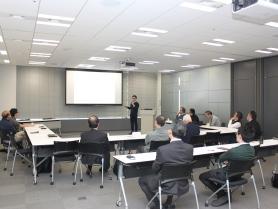Event Report Global Economy
CIGS Workshop "Firms and Markets in Historical Perspectives"
December 22, 2017,
15:00
- 17:00
Venue: CIGS Meeting Room3




(Mr. Okazaki, Mr. Miyakawa and Mr. Wakamori from the left)
Presenter: Daisuke Miyakawa, Associate Professor, The Graduate School of International Corporate Strategy, Hitotsubashi University
Title: "Pricing-To-Market and Networks"
Presentation slides:
Presentation slidesPDF:1363KB
Presentation outline:
Using firm-level monthly export price data for a narrowly defined product, i.e., cotton yarn of a specific count, set by Japanese firms over the periods from 1897 to 1914 and detailed firm-level attributes, we empirically examine how firms' Pricing-To-Market (PTM) behavior depends on firm heterogeneity. The estimate results show that the factors related to cotton producers' human networks with banks, trading companies, and trade exchanges were closely related to PTM behavior. This result is obtained under the estimation properly controlling for a comprehensive list of firm attributes such as exporter firms' wages, import intensity, and firm size, all of which have been confirmed to be the important determinants of PTM.
Presenter: Tetsuji Okazaki, Research Director, CIGS / Professor, Graduate School of Economics, The University of Tokyo
Title: "Market Access, Technology and Plant Lifecycle: A Natural Experiment from Opening of Japan in 1859"
Presentation slides:
Presentation slidesPDF:943KB
Presentation outline:
This paper examines how trade regime change affected the lifecycle of manufacturing plants. For this purpose, we exploited the historical event of Japan's opening trade in 1859 as a natural experiment. Based on the plant-level data for 1902 and 1919 with each plant's entry year, we examined how lifecycles of plants differed between the periods before and after 1859. It was found that lifecycles of plants were indeed different between these two periods: (1) a plant grew much faster as it aged after 1859 than before 1859, (2) this effect is larger for the plants in exporting industries and the plants located in metropolitan areas, (3) The plant size at entry was larger for the plants that entered after 1859 than those that entered before 1859. The difference in the plant lifecycles between the periods before and after 1859 was confirmed by long-term time series data covering both of the two periods. Based on these findings, we argue that the access to markets and advanced technologies affected the lifecycle of plants.
Presenter: Naoki Wakamori, Assistant Professor, Faculty of Economics, The University of Tokyo
Title: "Excess Capacity and Effectiveness of Policy Interventions: Evidence from the Cement Industry"
Presentation slides (Japanese):
Presentation slides (Japanese)PDF:204KB
Presentation outline:
Excess production capacity has been a major concern in many countries, in particular, when the industry faces declining demand. Strategic consideration of firms might delay efficient scrappages of production capacity and policy interventions which eliminate such strategic behavior may improve efficiency. This paper empirically studies the effectiveness of policy interventions in such an environment using the Japanese cement industry. We find that capacity coordination can effectively reduce excess capacity without distorting firms' scrappage decisions.
CIGS Workshop is a presentation of the progress for the study which CIGS researchers are doing. They take comments from other researchers, advisors, and outside commentators, and they make use of them for their future study.
